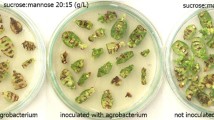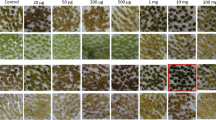Summary
The xylose isomerase genes (xylA) from Thermoanaerobacterium thermosulfurogenes and Streptomyces rubiginosus were introduced and expressed in three plant species (potato, tobacco and tomato) and transgenic plants were selected on xylose-containing medium. The xylose isomerase genes were transferred to explants of the target plant by Agrobacterium-mediated transformation. The xylose isomerase genes were expressed under the control of the enhanced cauliflower mosaic virus 35S promoter and the Ω′ translation enhancer sequence from tobacco mosaic virus. In potato and tomato, xylose isomerase selection was more efficient than the established kanamycin selection. The level of enzyme activity in the regenerated transgenic plants selected on xylose was 5–25-fold higher than the enzyme activity in control plants selected on kanamycin. The xylose isomerase system enables transgenic cells to utilize xylose as a carbohydrate source. In contrast to antibiotic or herbicide resistance-based system where transgenic cells survive on a selective medium but nontransgenic cells are killed, the xylose system is an example of a positive selection system where transgenic cells proliferate while non-transgenic cells are starved but still survive. The results show that a new selection method, is established. The xylose system is devoid of the disadvantages of antibiotic or herbicide selection, and depends on an enzyme which is already being widely utilized in specific food processes and that is generally recognized as safe for use in the starch industry.
Similar content being viewed by others
References
ACNFP. Report on the use of antibiotic resitance markers in genetically modified food organisms. London: Advisory Committee on Novel Foods and Processes Deparment of Health and Ministry of Agriculture, Fisheries and Food: 1994.
AMFEP. Regulatory aspects of microbial food enzymes, 4th edn. Brussels: Association of Microbial Food Enzyme Producers; 1992.
Bojsen, K.; Donaldson, I.: Haldrup, A.; Joersboe, M.; Kreiberg, J. D.; Nielsen, J.; Okkels, F. T.; Petersen, S. G. Mannose or xylose based positive selection. Patent Application, International Application Number PCT/EP94/00575, International Publication Number WO 94/20627. World Intellectual Property Organization; 1994.
Calgene Inc. Request for advisory opinion regarding whether the kanamycin resistance gene, a selectable marker, may be used in the production of genetically engineered tomato, cotton, and rapeseed plants intended for human food and animal feed use. FDA Docket Number 90A-0416; 1990.
Callens, M.; Kerster-Hilderson, H.; Opstal Van, O.; Bruyne De, C. K. Catalytic properties of d-xylose isomerase from Streptomyces violadeoruber. Enzyme Microb. Technol. 8:696–700; 1986.
Commission of the European Communities. Opinion of the Commission. Pursuant to article 251 (2) (c) of the EC treaty, on the European parliament's amendments to the Council's common position regarding the proposal for a directive of the European parliament and of the council on the deliberate release into the environment of genetically modified organisms and repealing Council. Directive 90/220/EEC; 2000.
David, J. D.; Wiesmeyer, H. Control of xylose metabolism in Escherichia coli. Biochim. Biophys. Acta 201:497–499; 1970.
Dekker, R. F. H.; Richards, G. N. Hemicellulases: their occurrence, purification, properties, and mode of action. Adv. Carbohydr. Chem. Biochem. 32:27–32; 1976.
Dietze, J.; Blau, A.; Willmitzer, L. Agrobacterium-mediated transformation of potato. In: Potrykus, I.; Sprangenberg, G., eds. Gene transfer to plants. Berlin, Heidelberg: Springer-Verlag; 1995:24–39.
Flavell, R. B.; Dart, E.; Fuchs, R. L.; Fraley, R. T. Selectable marker genes: safe for plants? Bio/Technology 10:141–144; 1992.
Fuchs, R. L.; Ream, J. E.; Gammond, B. G.; Naylor, M. W.; Leimgruber, R. M.; Berberich, S. A. Safety assessment of the neomycin phosphotranferase II (NPTII) protein. Bio/technology 11:1543–1547; 1993.
Haldrup, A.; Petersen, S. G.; Okkels, F. T. Positive selection: a plant selection principle based on xylose isomerase, an enzyme used in food industry. Plant Cell Rep. 18:76–81; 1998a.
Haldrup, A.; Petersen, S. G.; Okkels, F. T. The xylose isomerase gene from Thermoamaerobacterium thermosulfurogenes allows effective selection of transgenic plant cells using d-xylose as the selection agent. Plant Mol. Biol. 37:287–296; 1998b.
Hall, J. C.; Kassi, P. K.; Spencer, M. S.; Born, W. H. V. An evaluation of the role of ethylene in herbicidal injury induced by pieloram or clopyralid in rapessed and sunflower plants. Plant Physiol. 79:18–23; 1985.
Hilden, L.; Leggio, L. L.; Larsen, S.; Poulsen, P. Characterization and crystallization of an active N-terminally truncated form of the Escehrichia coli glycogen branching enzyme. Eur. J. Biochem. (FEBS) 267:2150–2155; 2000.
Hodal, L.; Bochardt, A.; Nielsen, J. E.; Mattsson, O.; Okkels, F. T. Detection, expression and specific elimination of endogeneous β-glucuronidase activity in transgenic and non-transgenic plants. Plant Sci. 87:115–122; 1992.
Joersboe, M.; Okkels, F. T. A novel principle for selection of transgenic plant cells: positive selection. Plant Cell Rep. 16:219–221; 1996.
Kasai, F.; Bayer, D. E. Effects of 2,4-dichlorophenoxyacetic acid, antiauxins, and metabolic perturbations on cytoplasmic and vacuolar pH of corn root tips measured by in vivo 31P-NMR. Pestic. Biochem. Physiol. 51:160–161; 1995.
Kristo, P.; Saarelained, R.; Gagerström, R.; Aho, S.; Korhola, M. Protein purification, and cloning and characterization of the cDNA and gene for xylose isomerase of barley. Eur. J. Biochem. 237:240–246; 1996.
Lee, Y.-E.; Ramesh, M. V.; Zeikus, J. G. Cloning, sequencing and biochemical characterization of xylose isomerase from Thermoanaerobacterium saccharolyticum strain B6A-RI. J. Gen. Microbiol. 139:1227–1234; 1993.
Murashige, T.; Skoog, F. A revised medium for the rapid growth and bioassay with tobacco tissue cultures. Physiol. Plant. 15:473–497; 1962.
Nap, J.-P.; Bijvoet, J.; Stiekema, W. J. Biosafety of kanamycin-resistant transgenic plants. Transgenic Res. 1:239–249; 1992.
Nissen, P.; Minocha, S. C. Inhibition by 2,4-D of somatic embryogenesis in carrot as explored by its reversal by difluoromethylornithine. Physiol. Plant. 89:673–680; 1993.
Okkels, F. T.; Whenham, R. J. Method for the selection of genetically transformed cells and compounds for use in the method. International Publication Number WO 93/05163 World Intellectual Property Organization; 1992.
Sanchez, S.; Smiley, K. L. Properties of d-xylose isomerase from Streptomyces albus. Appl. Microbiol. 29:745–750; 1975.
Shamanna, D. K.; Sanderson, K. E. Uptake and catabolism of d-xylose in Salmonella typhimurium LTZ. J. Bacteriol. 139:64–70; 1979.
Takasaki, Y.; Kosugi, Y.; Kanbayashi, A. Streptomyces glucose isomerase. In: Perlman, D., ed. Fermentation advances. Recent advances in fermentation technology. New York:Academic Press; 1969:561–589.
van der Leij, F. R.; Visser, R. G. F.; Oosterhaven, K.; van der Kop, D. A. M.; Jacobsen, E.; Feenstra, W. J. Complementation of the amylose-free mutant of potato (Solanum tuberosum L.) by the gene encoding granule-bound starch synthase. Theor. Appl. Genet. 82:289–295; 1991.
van der Steege, G.; Nieboer, M.; Swaving, J.; TempeIaar, M. J. Potato granule-bound starch synthase promoter-controlled GUS expression: regulation of expression after transient and stable transformation. Plant Mol. Biol. 20:19–30; 1992.
Yamanaka, K. Purification, crystallization and properties of the d-xylose isomerase from Lactobacillus brevis. Biochim. Biophys. Acta 151:670–680; 1968.
Zahnley, J. C.; Axelrod, B. d-Xylukinase and d-ribulokinase in higher plants. Plant Physiol. 40:372–378; 1965.
Author information
Authors and Affiliations
Corresponding author
Rights and permissions
About this article
Cite this article
Haldrup, A., Noerremark, M. & Okkels, F.T. Plant selection principle based on xylose isomerase. In Vitro Cell.Dev.Biol.-Plant 37, 114–119 (2001). https://doi.org/10.1007/s11627-001-0022-1
Received:
Accepted:
Issue Date:
DOI: https://doi.org/10.1007/s11627-001-0022-1




